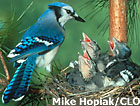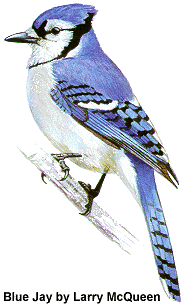|
Common,
conspicuous, and noisy, Blue Jays are capable of making a wide variety of sounds. In
addition to the loud and often heard jay! jay! call, a bell-like tull-ull call, a
melodious whistled teekle, and a variety of chattering, harsh notes and growls may be
heard. Blue Jays also produce a remarkable imitation of the scream of a Red-shouldered
Hawk.
When around the nest, Blue Jays become more quiet. The nest is usually situated between
8 and 20 feet up in a coniferous, or occasionally, deciduous tree. The nests of other
passerines are sometimes appropriated by these jays. The female incubates most of the
eggs, and she may be fed by the male while on her nest. Both parents bring food for the
hatchlings. In late summer and fall, Blue Jays travel in small flocks and family groups.
The Blue Jay's range extends throughout deciduous forests, parks, and residential areas
across eastern North America from Newfoundland to central Alberta, and south to Florida
and eastern Texas. Mixed woodlands with oaks and beeches are preferred. The western edge
of the range stops abruptly where the arid pine forest and scrub habitat of the closely
related Steller's Jay (Cyanocitta stelleri) begins. Recently, the range of the Blue Jay
has extended to the Northwest so that it is now a regular but still-rare autumn migrant
along the northern Pacific Coast. The popularity of bird feeding is thought to have
promoted an increase in the population of Blue Jays in the Northeast.
Northern populations migrate south, sometimes in large flocks of up to 250 birds.
Typically, the noisy jays are quite noticeable, but Blue Jays tend to fly high and quietly
during migration.
Description:
Blue Jays are medium-sized (approximately 11 inches in length), colorful birds
with crests. Their crown and crest are light violet-blue. Under the base of the crest and
extending through the eyes across the forehead is a black band. Over the eye is a short
white superciliary stripe; ear coverts, cheek, and throat are also white. Below the throat
is a narrow black necklace that extends upward and connects behind the ear-coverts with
the black head band. The lower breast, belly, and vent area are off-white.
The upper parts are bluish gray and
brightest on the rump. The wings and tail are bright sky-blue with heavy black barring.
The wings show a single, broad white wingbar as well as white-tipped secondary feathers.
The corners of the tail are white also. Blue Jays are dull gray underneath the tail and
wings, except for white feather tips. Their bill, legs, and eyes are all blackish. Both
sexes are similar in appearance.
Steller's Jays and Blue
Jays are the only North American jays with barring on their wings and tails. Both are
crested, but the Steller's Jay has a dark, almost black, head and crest and lacks any
white underneath. |

Blue Jay

Blue Jay with nestlings
|


